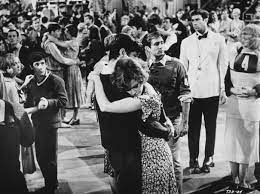One reason "They don't make movies like they used to" is because They Shoot Horses, Don't They? Rather, they don't make mainstream movies like the offbeat 1969 drama. Although powerful and gripping, with outstanding performances by the cast, They Shoot Horses, Don't They? would be far too nihilistic for a wide modern audience. Sure, someone could make a film this melodramatically dark, but don't expect audiences to turn the feature into a big hit like ticket buyers did more than five decades ago.
Dance Away the Inhumanity
They Shoot Horses, Don’t They? isn’t a film about horses. Instead, the feature focuses on humans being treated worse than animals. In the film’s opening, someone shoots a horse that suffers a broken leg, a sad incident, but the shooter intends to end the life of a suffering creature humanly.
The title may imply a tragic western along the lines of John Wayne’s The Shootist (1976). This Sidney Pollack film isn’t an “oater,” as Post-World War I Santa Monica’s seaside location has nothing to do with dusty Arizona or Texas towns. No one rides horses, but the many characters dance.
The film involves a marathon dance contest where desperate partners dance for hours on end, with few breaks and great suffering, to win a $1,500 prize. The Great Depression rages, and some participants have no other options in life. So, these sad strangers come together for a shot at the winner-takes-all prize. They also subject themselves to horrible debasement.
The dance contest promoters have little or no care for the troubled souls putting their health at risk. The dancers are like horses, maltreated horses. Those in charge of the rodeo ride them into the ground, caring not about their lives.
As depressing as They Shoot Horses, Don’t They? is the film provides telling insights into human nature. Amoral people take advantage of the downtrodden, and those with few options in life must go along with the scheme. A longshot, no matter how degrading, brings some chance at financial - and potentially spiritual - renewal.
Critics adored the engrossing film, which rose to “classic new wave cinema” status. The question remains - what compelled audiences to purchase $12 million in tickets to see this dark, downbeat experiment?
They Watch Dramatic Shockers, Didn't They?
A film’s “shock factor” may involve more than excessive violence or adult content. Controversial plots might stun audiences not expecting to see what they encounter, and even a realistic melodrama could leave audiences uneasy. Since the film’s controversy comes from human drama and not exploitation, a larger audience might be willing to explore the film. The chances for such a ticket-selling outcome were likely much greater in 1969 than today. Movies were mostly G and PG-rated affairs, at least since the end of the pre-code days.
Younger persons forget that the average home had only four to six television channels, and network and local standards and practices kept things mostly at or below PG levels. Content could be controversial, but nihilism wasn’t typical network broadcast material - unless the networks chose to broadcast an edited version of a successful and controversial motion picture. Viewing an uncut version required visiting the theater. The controversy created curiosity, and audiences would pay to see downbeat films. At least they were more inclined to do so in the 1960s and 1970s.
Please check out my collection of essays on Amazon Kindle - Universal Monsters and Neurotics: Children of the Night and Their Hang-Ups.



No comments:
Post a Comment